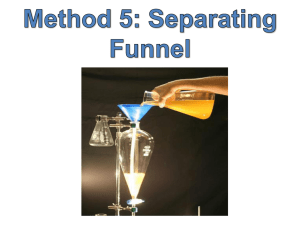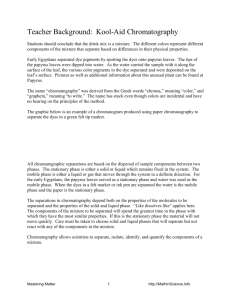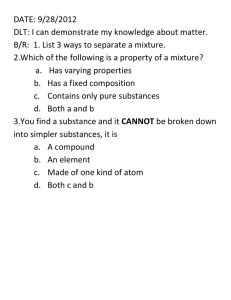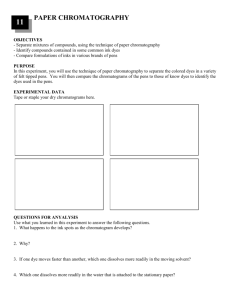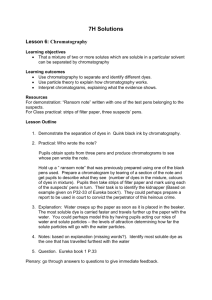Experiment 8
advertisement
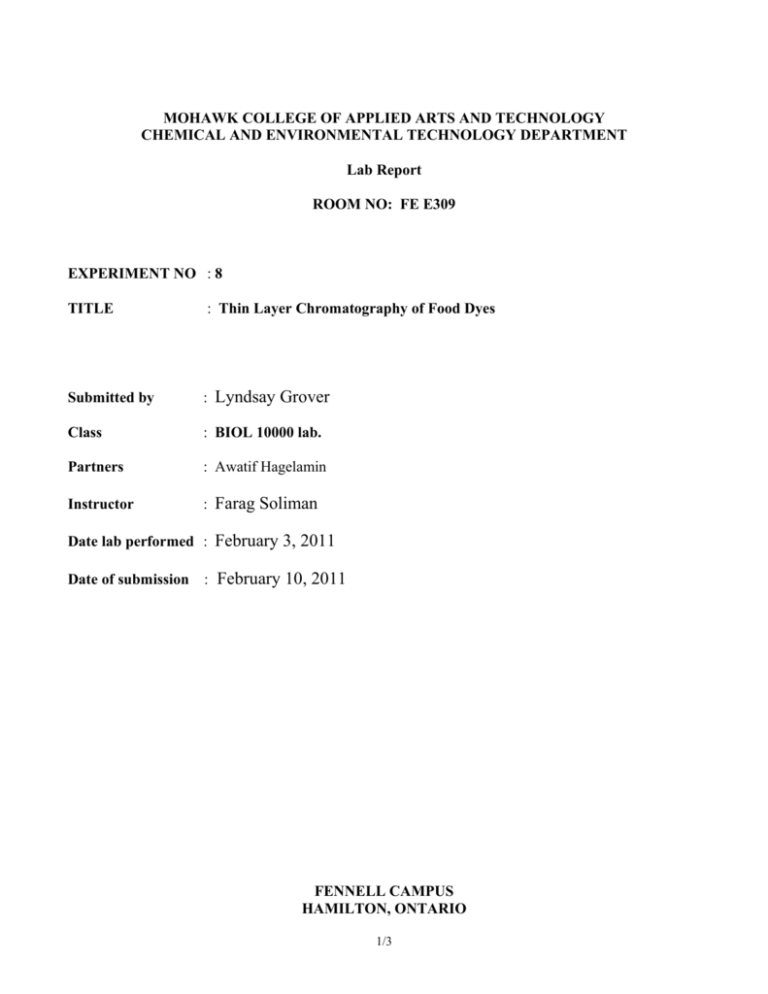
MOHAWK COLLEGE OF APPLIED ARTS AND TECHNOLOGY CHEMICAL AND ENVIRONMENTAL TECHNOLOGY DEPARTMENT Lab Report ROOM NO: FE E309 EXPERIMENT NO : 8 TITLE : Thin Layer Chromatography of Food Dyes Submitted by : Lyndsay Grover Class : BIOL 10000 lab. Partners : Awatif Hagelamin Instructor : Farag Soliman Date lab performed : February 3, 2011 Date of submission : February 10, 2011 FENNELL CAMPUS HAMILTON, ONTARIO 1/3 Purpose: The purpose of this experiment was to observe the reactions of food dyes with thin layer chromatography paper in order to find the components of an unknown solution. The practical applications of thin layer chromatography involving food dyes are to find the known food dyes in an unknown solution, which could be useful in safety testing as well as testing for food dyes in terms of allergies. Procedure: We began by preparing four small sheets of thin layer chromatography paper, two per person so there would be duplicates of the results. We then pipetted five known dyes and two unknown solutions onto the paper. We then allowed them to develop in the solvent. After the solvent had raised a desirable amount up the chromatography paper we removed it, allowed it to dry and then measured the solvent front, distance to dots and the computed the Rf values. Data/Observations: Table 1 Colour in Solution Colour as a Dried Spot Colour After Development Dark Red Red Dark Red Dark Purple/Red Burgundy Fuchsia Orange-Yellow Orange Orange, Yellow Dark Green Green Blue, Yellow Dark Blue Blue Blue, Pink Dark Red/Orange Yellow Yellow, Pink Dark Red/Brown Brown Red, Blue, Yellow Dyestuff Pink Cochinea Egg Yellow Green Blue Mixture A Mixture B Dyestuff Spots Observed Pink a b c a b c a b a b a b c a b Cochinea Egg Yellow Green Blue Mixture A Table 2 Distance to Solvent Front (cm) 3.6 3.6 3.6 3.6 3.6 3.6 3.6 3.6 3.6 3.6 3.6 3.6 3.6 3.6 3.6 2/3 Distance to Spot Center (cm) 0.3 0.9 2.1 0.3 0.9 2.1 0.4 0.9 0.3 0.5 0.4 1 1.3 0.6 1.3 Rf values 0.0833 0.25 0.583 0.0833 0.25 0.583 0.111 0.25 0.0833 0.138 0.111 0.277 0.361 0.166 0.361 Mixture B c d a b c d 3.6 3.6 3.6 3.6 3.6 3.6 1.7 2.3 0.3 0.6 0.9 1.1 0.472 0.638 0.0833 0.166 0.25 0.305 Calculations: 0.3/3.6cm= 0.0833 0.9/3.6cm= 0.25 2.1/3.6cm= 0.583 0.4/3.6cm= 0.111 0.5/3.6cm= 0.138 1.0/3.6cm= 0.277 1.3/3.6cm= 0.361 0.6/3.6cm= 0.166 1.7/3.6cm= 0.472 2.3/3.6cm= 0.538 1.1/3.6cm= 0.305 Discussion: In this experiment there are very few sources of error due to the experiments simplistic nature but these errors could dramatically change the results if they were to occur. Possible sources of error could include: dye contamination, incorrect solution strength, and insufficient development time. Dye contamination could have occurred if one dye bled over into the other dyes lane, thus corrupting the reaction for that dye because of a foreign component. Incorrect solution strength could have not included enough of the component needed to create the proper reaction with the food dyes, preventing the separation of components in the dye. Insufficient development time would mean that the reaction was not able to be completed fully so the dye components may not have risen up the solvent front to their proper height or may not have been able to completely separate. I do not believe any of these sources of error occurred in our experiment. There was no dye contamination since none of the dyes bled over into the other lanes. The solution seemed to be the correct concentration since the dyes did react with the solvent and did move up with the solvent and separated in the process. As well the chromatography paper was left in the solvent for a sufficient amount of time and was able to rise up to the desired height. Conclusion: When observing the spots created by the known dyes we can apply these known patterns to the unknown mixtures to determine their components. For Mixture A it appears to have two components to the mixture, as to the dyes involved it is still unknown since it does not match any of the known dyes. The only known dye I could guess as to be one of the components would be egg yellow. For Mixture B it appears to have 3 components to the mixture. The components it contains appears to be pink, green and blue. The first dot seems to be the base dot for red slightly tinted by the base dot for green. Then follow by the yellow component of the green dye, then the blue and the red with the small yellow component at the very top. So in summary Mixture A contains two components though still unknowns and mixture B contains three components composed of pink, green and blue. 3/3

